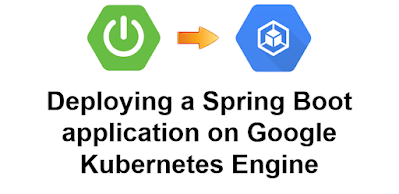Deploying a Spring Boot application on Google Kubernetes Engine
In this section, we will learn how to deploy a Spring Boot application in Google Kubernetes Engine.
1. A little bit of Background
Google Kubernetes Engine
Spring Boot
2. Creating a simple spring boot web application
Then, Provide the Group and Artifact name. We have provided Group name com.knf.dev.demo and Artifact spring-boot-hello-world. Here I selected the Maven project - language Java 11 - Spring Boot 2.7.8 and add Spring web dependency.
Then, click on the Generate button. When we click on the Generate button, it starts packing the project in a .zip(spring-boot-hello-world) file and downloads the project. Then, Extract the Zip file.
Then, import the project on your favourite IDE.
Final Project directory:
pom.xml
<?xml version="1.0" encoding="UTF-8"?>
<project xmlns="http://maven.apache.org/POM/4.0.0"
xmlns:xsi="http://www.w3.org/2001/XMLSchema-instance"
xsi:schemaLocation="http://maven.apache.org/POM/4.0.0
https://maven.apache.org/xsd/maven-4.0.0.xsd">
<modelVersion>4.0.0</modelVersion>
<parent>
<groupId>org.springframework.boot</groupId>
<artifactId>spring-boot-starter-parent</artifactId>
<version>2.7.8</version>
<relativePath/> <!-- lookup parent from repository -->
</parent>
<groupId>com.knf.dev.demo</groupId>
<artifactId>spring-boot-hello-world</artifactId>
<version>0.0.1-SNAPSHOT</version>
<name>spring-boot-hello-world</name>
<description>Demo project for Spring Boot</description>
<properties>
<java.version>11</java.version>
</properties>
<dependencies>
<dependency>
<groupId>org.springframework.boot</groupId>
<artifactId>spring-boot-starter-web</artifactId>
</dependency>
<dependency>
<groupId>org.springframework.boot</groupId>
<artifactId>spring-boot-starter-test</artifactId>
<scope>test</scope>
</dependency>
</dependencies>
<build>
<plugins>
<plugin>
<groupId>org.springframework.boot</groupId>
<artifactId>spring-boot-maven-plugin</artifactId>
</plugin>
</plugins>
</build>
</project>
Create Hello Controller
package com.knf.dev.demo.controller;
import org.springframework.web.bind.annotation.GetMapping;
import org.springframework.web.bind.annotation.RestController;
@RestController
public class HelloController {
@GetMapping("/hello")
public String getMessage()
{
return "Hello World!";
}
}
Application.java
package com.knf.dev.demo;
import org.springframework.boot.SpringApplication;
import org.springframework.boot.autoconfigure.SpringBootApplication;
@SpringBootApplication
public class Application {
public static void main(String[] args) {
SpringApplication.run(Application.class, args);
}
}
3. Create a New Repo and Upload Files on GitHub
First, sign in to Github https://github.com/
Then, create a new repository "spring-boot-hello-world".
Then, upload the source code from your local machine to the newly created Github repo.
4. Create a GCP Project
First, Sign into the Google console at https://console.cloud.google.com.
You can create a new project by first selecting the project dropdown in the top left and selecting "New Project".
5. Build the Docker-image for Spring Application & push the docker image to Google's Container Registry
git clone https://github.com/knowledgefactory4u/spring-boot-hello-world.git
Change the directory to spring-boot-hello-world
cd spring-boot-hello-world
Create the JAR deployable for the app.
mvn -DskipTests package
You will see the following similar output in your cloud shell:
Enable Container Registry to store the container image that we will create.
gcloud services enable containerregistry.googleapis.com
You will see the following similar output in your cloud shell:
Next, use Jib to create the container image and push it to the Container Registry.
export GOOGLE_CLOUD_PROJECT=`gcloud config list --format="value(core.project)"`
mvn -DskipTests com.google.cloud.tools:jib-maven-plugin:build \ -Dimage=gcr.io/$GOOGLE_CLOUD_PROJECT/spring-boot-hello-app:v1
If everything goes fine, you will see the following similar output in your cloud shell:
Check whether the image is pushed in Google Container Registry
From cloud console, search for "Container Registry" like below and click on "Container Registry" button.
You will see the image name which has been pushed.
6. Create Kubernetes Cluster
First, make sure that the related API features are enabled.
gcloud services enable compute.googleapis.com container.googleapis.com
You will see the following similar output in your cloud shell:
Then, create a cluster by executing below command.
gcloud container clusters create spring-boot-hello-cluster --num-nodes=2 --region=asia-southeast1-a
You will see the following similar output in your cloud shell:
You can change the cluster name, number of nodes and region as you wanted. But, if you don’t know which region to select, you can find more information from this region link.
Now you’ve got a Kubernetes Cluster.
From cloud console, search for "Kubernetes Engine" like below and click on "Kubernetes Engine" button.
You can see the name of your Kubernetes Cluster.
7. Deploy Spring Application on Kubernetes
Create a Deployment for Spring App docker image:
kubectl create deployment spring-boot-hello-app \ --image=gcr.io/$GOOGLE_CLOUD_PROJECT/spring-boot-hello-app:v1
To View the Deployment that we just created:
kubectl get deployments
You will see the following similar output in your cloud shell:
To View, the Spring Application Pod instances created by the deployment:
kubectl get pods
You will see the following similar output in your cloud shell:
Now we have a Container running under the control of Kubernetes, now it's time to make it accessible to the outside world.
8. Allow External Traffic
In Cloud Shell, you can expose the Pod to the public internet by creating a Kubernetes LoadBalancer service.
kubectl create service loadbalancer spring-boot-hello-app --tcp=8080:8080
Check the Service that we just created,
kubectl get services
You will see the following similar output in your cloud shell:
Verify that Spring Boot App is running,
Next section: Deploy a Spring Boot application in Google Cloud App Engine - Click here!


























